-
Content Count
1,358 -
Joined
-
Last visited
Content Type
Profiles
Forums
Calendar
Posts posted by TriumphV8
-
-
Indeed, some of the axles have it, some very less.
It is not in the joint itself but inside the joint, where the axle plugs in.
Seems to be a little bit difficult to get that job done without play or sticking.
That is why I welded mit axles together from two stock pieces with works toothed gears on ist.
Anyway that will not cause a clong, I would recommend to make a testdrive on steel wheels.
When braking the wheels turn backward and under accelerating in first they turn and give that noise.
-
On 12/30/2019 at 1:03 PM, russellbaldwin said:
I have a 75 TR6, UK car running standard fuel injection.
And if the answer is electronic - which is the best setup?
A perfect normal ignition can do all the things required from the swap to breatherless ignition.
Unfortunately the original ignition very often is not in good shape and PI needs high quality what
in reality ends up with performance loss.
I found a real power loss with a normal coil and worst was that I did nor recognize misfire.
Performance increased with a Bosch red coil. I did not expect that but that was tested on the rolling road.
So I went to CDI as there is MSD6 or similar to be on the safe side.
Many discussions had been made here for full mapable electronic ignition.
Although there are some negative comments I am happy with that, giving the engine up to 45 degree
max advance at high revs/low loads. Result is crispy response on throttle, about 0.5litre less fuel consumption on 100km.
Part throttle advance is something all modern engines have and TR6 PI not.
Only with swap from points to breakerless this will nor be cured.
123tune is the easiest way to cure all things but than the missing dizzy drive must be solved.
I use the 36-1 wheel at the front pulley and do the timing with MegaSquirt.
-
And take the Carbon fibre elements.
They can be cut and still work and best is to cut them for the inner part of the rear
because there some cable ties will be needed to tie the cover to the foam and so at
that area the heater sheet can not be positioned.
Cut to suit the inner part and glue with heat resistant Pattex.
Normally they come complete with two stage switch and relays.
Maybe they will do the job but never tested them, just to show the carbon fibre type
-
On 12/3/2019 at 5:18 AM, JochemsTR said:
I fitted a second feed last year after valves # 1 and 2 were running dry and the rockers and shaft were ruined.
For my second engine I plan to install the Goodparts Rockers/Shaft.....my understanding was that such needle bearings need proper lubrication which can only provided by a second feed. Correct?
Jochem
I use the second oil feed during running in and there is plenty of oil coming into the head and a bit leaving through the breather.
My intention was to prevent cam from running dry.
Later I reduced oil pass to a orifice 0.8mm.
There is few oil coming normally into the rocker shaft. It finds its way somewhere and maybe it drops out before the most far rockers are reached. That can be prevented by second oil feed but beware of head swimming in oil. By the way it will pass the valve guide into inlet so rubber caps are needed.
I did read the recommendation that rollers should have additional oil. I would expect needles do not need that, but Goodparts will know better but anyway I would limit oil splash with an orifice what size ever. Most important is to reduce spring power. Valve lift is much higher and springs might bind.
-
My set of bushed rockers lasted about 30Tkm.
Reason like many other new rockers is the not hardened tip that killed also the tip of the valve stem.
I use a fast road cam but valve springs close to CP data.
Although the bushings had been superior the rest was ready for the bin.
Never again. I am now on rollers from Goodparts, expensive and loud but reliable.
-
No need to worry
every modern car has a similar system.
Normal procedure is once tuned you forget that there is a special system for
fuel metering fitted and simply drive the car.....
Although EFI tuning is much easier than tuning carbs or the PI you should be aware
that some basic knowledge is important if you want to improve a system and not spoil it!
-
16 hours ago, ed_h said:
There was a thread on one of the forums a while back where someone installed temperature sensors at various places under the bonnet. One revelation was that, at road speed, underbonnet air temps were essentially the same as ambient.
Ed
Made similar investigations. on the highway all is in limits.
And the cold air intake itself and maybe the air filter robs some power.
With a crossflow head and air horns and some clean area from front to air horns
the race engines gave best results.
But at low speed and at traffic lights my V8 reported high MAT temps.
I changed the place of the sender several times but still found the results
did not make sense.
Anyway the MAT easily reached 60 degrees and often 80 could be found.
My EFI can correct a mismatch between measured MAT and calculated fuel.
Especially in traffic jam, at hot start or slow driving this correction is quite busy
showing me that the perfect place for MAT measuring is yet not found.
In our case it shows that under bonnet temperature has quite a large influence
on the mixture quality.
-
16 hours ago, RobH said:
I thought a constant-depression carb like SU and Stromberg does sort of compensate for air pressure. Lower ambient air pressure means the piston doesn't rise as far to maintain the depression and so keeps the mixture correct?
The SU senses the pressure difference between outside (top of diaphragm or piston)
and pressure loss in the venturi built by the piston at underside of piston where air blows
by into the engine. So more or less it senses the air speed and lifts the piston to keep it
nearly constant. The needle gives at that position the correct amount of fuel by its varying
diametre.
From that some correction is done but the air that is sucked in is different, too.
As air changes density with low pressure air flowing through at underside of piston it
now has less oxygen per litre and so carb "sees" another air media than he was set before.
Mixture becomes richer like air is warmer what has same effect.
-
There are three problems the non EFI community is dealing with:
1.) As told warm air is less dense and transports less oxygen into the engine. This results in less feed.
2.) Carb and PI does not sense that and from that mixture is not correct.
3,) Due to weather and height the air pressure is different what PI and carb do not sense, too.
This is why racers had been set to perfect performance at the race track in the early days.
Besides the warm air that is sniffed in from the engine compartment or in summer from the outside, too
there is also the problem that the manifolds itself are heated from the exhaust and from the connection to cylinder head.
They give the heat to the mixture passing inside and increase the problems.
When making a dyno there is also a correction to be done where outside temperature and air pressure is needed for correction. This can be quite a lot in the range of +/- 5%
-
If EFI is on alpha/n proper TPS and TPS setting is essential.
If you are on speed density the TPS also is needed but not that much.
As you now can go pretty close to lean mixture limit the TBs must feed alls cylinders equal and injectors must spray same amount.
The connection (or two connections at CR) between the inlet runners help but in some throttle positions proper sync is needed.
-
Without a log it is difficult to judge from the distance.
You will need a wideband oxygen measurement to see what is wrong.
If engine idles perfect I would try 1500rpm when car standing still
and watch afr.
Beginning with a fuel table that needs a tweak it can be accel fuel unwanted clogging in
and VR sensor sending wrong data.
Also some problem with ignition should be checked if this is also done by ECU.
Pop in an old distributor and set it to be sure that this is not causing the problem.
Best is to establish a logging possibility. I am sure the ECU can do so.
-
The seats especially on the outlet get little dimples.
Also the seats become wider.
At minimum there should be regrind and a refacing
to the correct width. Most of the outlet dimples should be gone.
Inlet should show a clean grey seat.
Also the valves and inlet runners and outlet should be
cleaned from coal.
I personally would swap the valve guides to those with rubber caps
and grind the inlet runners to match the chamber. Also some material
can be cut to make a smooth canal both inlet and outlet.
As this can go wrong I would give that to a specialist.
It is power for free and does no harm, so I like that!.
I do not use seat rings because I expect head crack between inlet and outlet.
If seats are envisaged I would only fit outlet rings.
-
Due to the reason that the cam is casted into a cooled form
where the lobes are quickly cooled down often the base circle is not hard.
Best way to proceed is to risk a mark on the downrunning side of the lobe
5mm after the top. It will hurt but all other things are tricky. Normally my
grinder does a hardness test a short time before the finish grind that the mark
is away when finished.
But that is more the case when a stock cam is for regrind and they have to decide
whether they have to give it a final nitriding process to make it reliable again because
the grind might have hurt the hardened area.
As the base circle is grind down anyway I know that there often is no hard area.
-
Looks great, really professional work!
-
I expect the pressure regulator is at the fuel rail?
In that case the serious answer can only be measure the pressure
at the regulator output where it goes into the return line.
If there is pressure than the return line is too small.
As this is could be the case easily it might be a good idea not to measure at all
and add a fuel line in 8mm to be on the safe side.
-
21 hours ago, CK's TR6 said:
A point about individual runners. The runner length can be tuned to increase Volumetric Efficiency (= torque) at a particular RPM. Jaguar did some studies that achieved over 100% VE, but the torque band was pretty narrow. The other side of individual runners is deciding what fuel calculation type you want to use. Speed density calculations need a good manifold absolute pressure signal. Also, tip in throttle response is a big factor for driving on the street.
Most EFIs provide a smoothing tool to tame the pressure signal electronically from the manifold.
123tune for example is so lazy that the signal from a single WEBER DCOE can be used.
For EFI that is a bit too much because some hesitation in fuel management will occure.
We have to smoothen the signal become just suitable, but not more, not to sacrifice the crispy response
on pressing the pedal. From a point forward this will not be possible with a wild cam.
That point is sooner reached with a single throttle body like todays cars have and for
Triumph TR6 it is somewhere aroung the 280 degree cam.
At present we have a 300 degree cam tamed to provide the EFI with a proper signal.
It is taken from the original PI manifold that connects all the six runners.
Former ECUs and Software releases did not provide that function. I connected all
six runners with small tubes and let them feed a little box from where I provided a
tube towards the EFI. Was a bit tricky but also worked quite well. In those times the
rule was to use Manifold pressure and rpm for smooth cams and for wilder cams swap
to throttle position and rpm, called Alpha/n. I think the open source of Megasquirt, what
at that time was the ECU to choose, pushed the software into the right direction we have now.
It is quite simple: Look at the difference of the TR6 PI and Carb versions. They are more or less the same
except the PI manifold. So from my view it is okay to give the 6 individual runners a power increase of about
10-15 HP. Talking about VE we must accept that the size of the runners is a little bit big, especially the throttle
plates with 45mm would be good for 220HP. Also the runners are a bit short but there is not much space to
extend without making a new inlet. We have to live with that but have the benefit of long stroke/short rods
what will increase low end power.
-
20 hours ago, Bfg said:
Being a simple fella, might I ask if just extending the brake pedal lever might not be easier ?
I'd guess 1- 1.5" (25 - 40mm) longer would increase the leverage by a useful percentage ..and be very inexpensive to do.
Pete
The pedal feeling is a mix of force and travel way.
If you extend the lever the travel increases and the pedal feels like air in the brake.
The same will happen if you reduce the diametre of the master cylinder or increase
the diametre of the wheel cylinders.
The booster is a good way to use big master for short travel and have force added
to reduce the required force pressing the lever down.
-
Hi Mimosa, sooner or later the work and learning about EFI
will give a proportional result.
The Patton thing from my view is a very good solution for American market
where air pollution rules or availiability might regulate the tuning and the manifold.
The half way will give more than half the fun, no doubt, but you can see from others
experience it is like a drug. Good idea is individual inlet runners and ignition control.
You get some pretty horses and more fuel economy for free and that is an argument
if you spend time and money on the project.
I would not expect that a system out of the box, fitted without specific knowledge will
satisfy over a loner period. It needs the individual tweak and as that becomes very easy
and cheap compared with a Weber DCOE setup it would be stupid not to try to optimize.
Unfortunately I had to set several PIs in the nearer past and despite they all had pretty new
metering units none of them was at the perfect point to work. So will the EFI start whereever you buy it,
what system you will use and what setting you might copy from others, there will be a lot of potential hidden.
The difficulty is to build the hardware and understand all that details and get it work than later
together with the Laptop and Wideband Oxygen sensor.
The easy and sweet thing is to lean back and tweak it from the passenger seat to perfection.
-
This one looks nice, it is from Volvo 940
-
I will do my very best.......
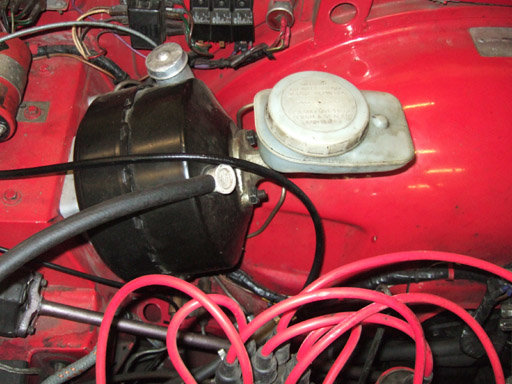
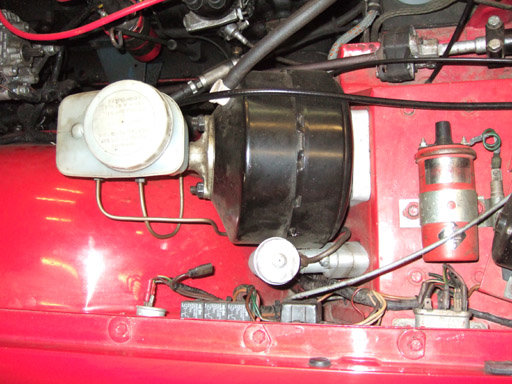
Unfortunately I forgot from what Volvo because I bought two used ones
and although the breaker told me I forgot through the years.
Take a look at Ebay and watch for the belt in the middle not too big
and the typical clean front towards the master..... It is 9" double diaphragmn.
-
I invented both the vented disc for front with spaced calipers
and the double diaphragm 9" Volvo booster.
The vented disc does not reduce pedal forces it is for not fading
that quickly happened before. Depends on the way to drive if needed at all.
Reducing power here is not recommened because with bigger calipers needed for that you will
change brake bias and rear will brake not that much it could brake for giving an overall shortest stopping way.
The brake booster is for reducing pedal forces and is from Volvo 242 if I remember correctly.
Master cylinder fits right out of the box but brake piping will be too short because the booster is longer.
At the bulkhead the bolt pattern is different.
Unfortunately the booster is a little bit bigger and interfears with the clutch master.
I made an extension to put the clutch master forward because it is only the reservoir
meeting the biggest diametre of the booster.
Other solutions make new bolt positions and move the whole booster inwards that the bulkhead holes
can be used and the clutch master must not be touched.
Brake forces are now lady like, all are happy. I use that for about two years
both vented discs and the booster.
-
These joints normally fail shortly from rotten rubber hose.
The grease inside is still perfect at that time.
I did some swaps with Poly hoses and still without grease nipples.
They last now for years.
-
Unfortunately this cam seems to be closer to the CR cam than similar to the CP cam you took off.
I would recommend to check the mixture under driving condition with a wideband AFR.
The timing should not be affected that much. If you do not have pinking aim for 20 degrees at 2000
and 30 degrees at 3000. That might require some of the higher 123 settings like "E".
Be prepared to swap the metering unit to a CR type due to higher vaccuum in the manifolds now.
-
As long as all cylinders get same AFR you do not need to worry about burned valves.
Before that our engine does not run nicely any more.
As long as you are not Scottish or German Schwäbisch you will recognice it as
really bad running and dislike that. The engine becomes lazy.
So under full load you should expect arounf AFR 12.5 - 12.7 for high performance and not burning valves
at part throttle you may go leaner but that will not work easily because the MU has no accell fuel.
Engine will go a bit lean whenever you push the pedal and that must still be a little bit richer than burning limit
of the fuel what is around AFR15.5.
Your personal taste is how much you are willing to suffer when accelerating. The hickup is not nice.
When engine accelerates just from closed throttle the sync of the throttle plates indicates how lean you can go.
Good spindle bearings and nice lincage will allowe you around 13.5.
I would not go lean in that area although just from what the engine needs that would be okay.
It is simply not a nice feeling to drive.
So at part throttle AFR 14.7 and at full load 12.7 would be the perfect figures but the PI system limits that
a little bit and you will have to make compromises to meet your individual taste.
As long as you do not go lean under load you will not kill an engine.
Missing cylinders at any state of manifold depression is an alarm signal and must be cured.


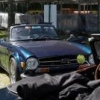
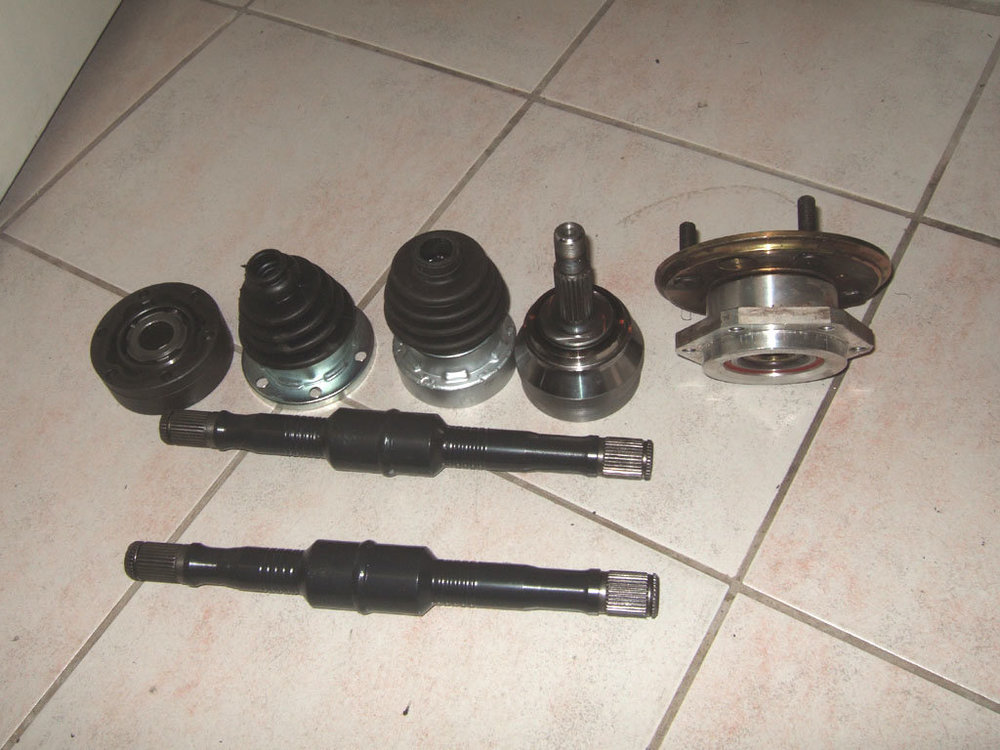
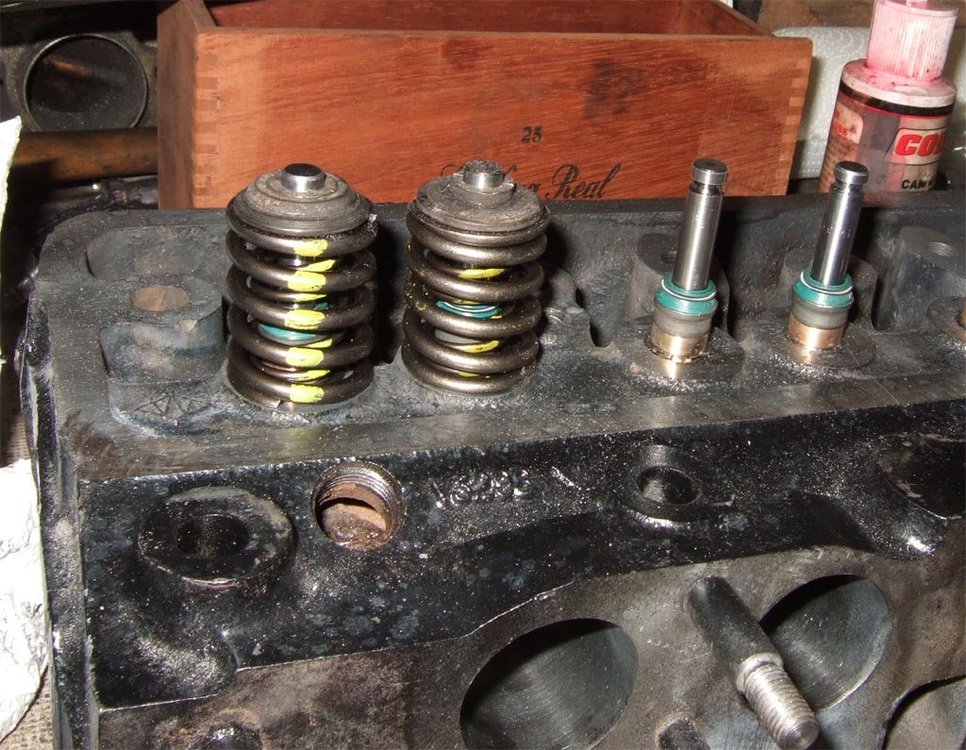
Rocker Shaft & Valves
in TR6 Forum
Posted
It is pretty normal, that there are some oil holes preferred
but they should not be blocked. Even with the additional oil line
some rockers stay nearly dry.
With the cam I would recommend to check the max lift and lift at TDC
With these data there might be a hint, what is in use.
Would not be that problem if there would not be the Kent or Bastuck cam
that requires much more clearance. If you have it and give it 0.01" clearance
the valves might fail and spoil the engine.
A coarse hint might be that the Kent is set 5 degrees advance what means
at TDC the inlet valve is more open than the exhaust. All the others I know
have same lift at TDC.